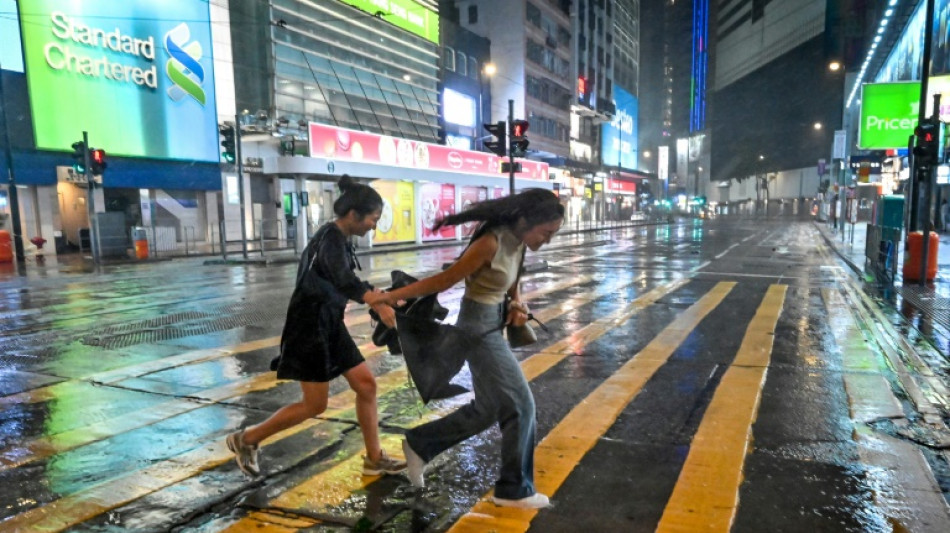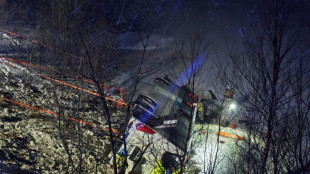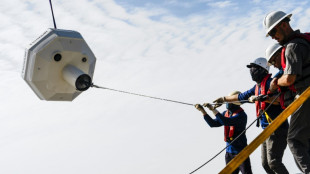
-
 Duffy bowls New Zealand to T20 victory over Sri Lanka
Duffy bowls New Zealand to T20 victory over Sri Lanka
-
Turkey's pro-Kurd party to meet jailed PKK leader on Saturday

-
 Gaza hospital shut after Israeli raid, director held: health officials
Gaza hospital shut after Israeli raid, director held: health officials
-
Surgery for French skier Sarrazin 'went well': federation

-
 Mitchell, Bracewell boost New Zealand in Sri Lanka T20
Mitchell, Bracewell boost New Zealand in Sri Lanka T20
-
Kyrgios says tennis integrity 'awful' after doping scandals

-
 S. Korean prosecutors say Yoon authorised 'shooting' during martial law bid
S. Korean prosecutors say Yoon authorised 'shooting' during martial law bid
-
Vendee Globe skipper Pip Hare limps into Melbourne after dismasting

-
 Reddy's defiant maiden ton claws India back into 4th Australia Test
Reddy's defiant maiden ton claws India back into 4th Australia Test
-
Doubles partner Thompson calls Purcell doping case 'a joke'

-
 Reddy reaches fighting maiden century for India against Australia
Reddy reaches fighting maiden century for India against Australia
-
Sabalenka enjoying 'chilled' rivalry with Swiatek

-
 Political turmoil shakes South Korea's economy
Political turmoil shakes South Korea's economy
-
New mum Bencic wins first tour-level match since 2023 US Open

-
 'Romeo and Juliet' star Olivia Hussey dies aged 73
'Romeo and Juliet' star Olivia Hussey dies aged 73
-
Brown dominates as NBA champion Celtics snap skid

-
 Indian state funeral for former PM Manmohan Singh
Indian state funeral for former PM Manmohan Singh
-
France asks Indonesia to transfer national on death row

-
 Ambitious Ruud targets return to top five in 2025
Ambitious Ruud targets return to top five in 2025
-
Late bloomer Paolini looking to build on 'amazing' 2024

-
 Australia remove Pant, Jadeja as India reach 244-7 at lunch
Australia remove Pant, Jadeja as India reach 244-7 at lunch
-
Scheffler sidelined by Christmas cooking injury

-
 Rice seeks trophies as Arsenal chase down 'full throttle' Liverpool
Rice seeks trophies as Arsenal chase down 'full throttle' Liverpool
-
Trump asks US Supreme Court to pause law threatening TikTok ban

-
 Arsenal edge past Ipswich to go second in Premier League
Arsenal edge past Ipswich to go second in Premier League
-
LawConnect wins punishing and deadly Sydney-Hobart yacht race

-
 Ronaldo slams 'unfair' Ballon d'Or result after Vinicius snub
Ronaldo slams 'unfair' Ballon d'Or result after Vinicius snub
-
Several wounded N.Korean soldiers died after being captured by Ukraine: Zelensky

-
 Fresh strike hits Yemen's rebel-held capital
Fresh strike hits Yemen's rebel-held capital
-
Netflix with Beyonce make splash despite NFL ratings fall

-
 Bird flu mutated inside US patient, raising concern
Bird flu mutated inside US patient, raising concern
-
Slovakia says ready to host Russia-Ukraine peace talks

-
 Maresca challenges Chelsea to react to Fulham blow
Maresca challenges Chelsea to react to Fulham blow
-
Tech slump slays Santa rally, weak yen lifts Japan stocks higher

-
 Test records for Zimbabwe and Williams as Afghanistan toil
Test records for Zimbabwe and Williams as Afghanistan toil
-
LawConnect wins punishing Sydney-Hobart yacht race

-
 Barca's Yamal vows to 'come back better' after ankle injury
Barca's Yamal vows to 'come back better' after ankle injury
-
Olmo closer to Barcelona exit after registration request rejected

-
 Watching the sun rise over a new Damascus
Watching the sun rise over a new Damascus
-
Malaysia man flogged in mosque for crime of gender mixing

-
 Montenegro to extradite crypto entrepreneur Do Kwon to US
Montenegro to extradite crypto entrepreneur Do Kwon to US
-
Brazil views labor violations at BYD site as human 'trafficking'

-
 No extra pressure for Slot as Premier League leaders Liverpool pull clear
No extra pressure for Slot as Premier League leaders Liverpool pull clear
-
Tourists return to post-Olympic Paris for holiday magic

-
 'Football harder than Prime Minister' comment was joke, says Postecoglou
'Football harder than Prime Minister' comment was joke, says Postecoglou
-
Driver who killed 35 in China car ramming sentenced to death

-
 Bosch gives South Africa 90-run lead against Pakistan
Bosch gives South Africa 90-run lead against Pakistan
-
French skier Sarrazin 'conscious' after training crash

-
 NATO to boost military presence in Baltic after cables 'sabotage'
NATO to boost military presence in Baltic after cables 'sabotage'
-
Howe hopes Newcastle have 'moved on' in last two seasons

| RBGPF | 100% | 59.84 | $ | |
| NGG | 0.66% | 59.31 | $ | |
| BCC | -1.91% | 120.63 | $ | |
| BCE | -0.93% | 22.66 | $ | |
| CMSD | -0.67% | 23.32 | $ | |
| RELX | -0.61% | 45.58 | $ | |
| JRI | -0.41% | 12.15 | $ | |
| SCS | 0.58% | 11.97 | $ | |
| RIO | -0.41% | 59.01 | $ | |
| RYCEF | 0.14% | 7.27 | $ | |
| GSK | -0.12% | 34.08 | $ | |
| AZN | -0.39% | 66.26 | $ | |
| BP | 0.38% | 28.96 | $ | |
| BTI | -0.33% | 36.31 | $ | |
| VOD | 0.12% | 8.43 | $ | |
| CMSC | -0.85% | 23.46 | $ |

Typhoon Saola slams southern China after battering Hong Kong
Typhoon Saola roared ashore in southern China early Saturday as a weakened but still dangerous threat that has lashed Hong Kong and forced millions to hunker down for one of the region's strongest storms in decades.
Tens of millions of people across Hong Kong, Shenzhen and other southern Chinese megacities had braced for the menace of a cyclone rated as a super typhoon.
And while it delivered a fierce but glancing blow to the special administrative region, Saola -- now downgraded to a severe typhoon -- landed south of Hong Kong with its toughest blows.
China's National Meteorological Center said Saola made landfall at around 3:30 am Saturday (2030 GMT Friday) to the south of the city of Zhuhai in Guangdong province, south of casino hub Macau.
Over 880,000 people were evacuated across two Chinese provinces ahead of Saola making landfall, hundreds of flights were cancelled across the region, and trees were uprooted around the rain-battered streets of Hong Kong.
China's national weather office predicted Saola "may become the strongest typhoon to make landfall in the Pearl River Delta since 1949", referring to a low-lying region that includes Hong Kong, Macau and much of Guangdong province.
With a direct hit possible, authorities in Hong Kong had raised the warning level Friday evening to the city's highest -- "T10" -- which had only been issued 16 times since World War II before Saola.
By 3:40 am, after more than seven long hours under T10, Hong Kong downgraded to level T8. But with dangerous gusts up to 139 kilometers (86 miles) per hour they urged residents to remain vigilant.
"As gales and violent squalls are still occurring in places, precautions should not yet be relaxed," the Hong Kong Observatory warned in a bulletin.
Still that marked a downgrade from 11:00 pm Friday, when Saola was just 30 kilometres south-southwest of the city, and packing sustained wind speeds of 185 kilometres per hour.
Hong Kong residents struggled with flailing umbrellas as they ran under the unrelenting rainfall, while people wearing plastic bags on their heads rushed home past sandbags stacked in waterfront areas to prevent flooding.
The observatory said "the maximum water level may reach a historical record", warning that "there will be serious flooding".
The last time Hong Kong issued a T10 warning was in 2018, when Typhoon Mangkhut slammed into the city, shredding trees and unleashing floods, and leaving more than 300 people injured.
In mainland China, Mangkhut killed six people and impacted the lives of more than three million others.
Across the mainland border in neighbouring Guangdong province, authorities evacuated more than 780,000 people from high-risk areas, while eastern Fujian province saw more than 100,000 moved to safer ground.
Trains in and out of Guangdong were also suspended until 6:00 pm Saturday, while the national flood defence agency raised its emergency response for prevention to its second-highest level.
"It's going to affect our life," said Wu Wenlai, 43, who had to close his restaurant in a Shenzhen suburb.
"My eldest son was planning to fly to Chengdu today for university and his flight has been cancelled now."
- More intense typhoons -
Southern China is frequently hit in summer and autumn by typhoons that form in the warm oceans east of the Philippines and then travel west.
Climate change has increased the intensity of tropical storms, with more rain and stronger gusts leading to flash floods and coastal damage, experts say.
In Hong Kong, authorities received at least seven confirmed cases of flooding, as well as nearly 40 reports of downed trees. The city's hospital authority reported seven people seeking medical treatment during Saola.
Businesses taped up their glass displays and windows, while high-rise buildings swayed under the whipping gusts.
In eastern Heng Fa Chuen -- a coastal residential area and the site of devastation during 2018's Typhoon Mangkhut -- officers in orange vests urged storm-watchers to go home, as trees leaned sideways from the heavy gusts.
In the low-lying fishing village of Lei Yue Mun, which is prone to flooding, water seeped into shops, prompting residents to set up sandbags and board up doors.
burs-dhc/mlm/tjj
P.Cavaco--PC




